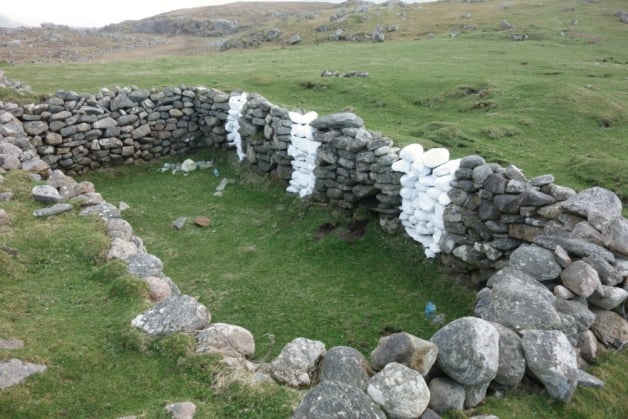Art World
Vandalism on the Scottish Highlands, or Environmental Art?
Are the white stripes painted on the ruins of a Scottish blackhouse graffiti—or art?

Are the white stripes painted on the ruins of a Scottish blackhouse graffiti—or art?

Sarah Cascone

In yet another instance of “is it artwork, or is it vandalism?,” (see artnet News reports on Prada Marfa and recent incidents involving work by Banksy and Ai Weiwei) the ruins of a traditional Scottish blackhouse believed to be the remains of an ancient nunnery has been painted with white stripes, reports the Scotsman.
Known locally as “the houses of the black women” in reference to the nuns who are said to have once lived there, the crumbling structure, located at Mealista in Uig on the Isle of Lewis, could be up to 500 years old.
According to Mark Miller Mundy, the local who discovered the paint job, this is not an isolated incident. In an interview with the Scotsman, he described the graffiti as “the latest example of a growing trend for visitors to create environmental sculptures in the landscape of Uig, which they then leave behind when they depart.”
If the three vertical stripes of white paint placed at regular intervals along the stone foundation of the blackhouse were truly intended as art, the artist has yet to step forward and claim responsibility.
That makes Jan Hogarth, the environmental creative director of Wide Open, which organizes creative public art programs throughout rural Scotland, skeptical. “It is very unusual for this to happen without any consultation with the local community. Usually there is a story behind the work,” she told the Scotsman. “Usually an artist doing environmental art would speak to the custodians of the building involved.”
“We were not notified about this particular piece of art being created,” confirmed John MacIver, chairman of Uig Historical Society, while speaking to the Scotsman. He went on to note that “whoever is responsible obviously took great care in what they were doing.”
Whatever the intention of the party responsible, the people of Uig are none too pleased with the alterations to the historic site. “These blackhouses hold a special significance to the community,” added MacIver. “Anything seen as vandalism is distressing.”
“Perhaps part of the idea is to do it anonymously,” speculated Hogarth. “We may find out from any publicity who this artist is.”